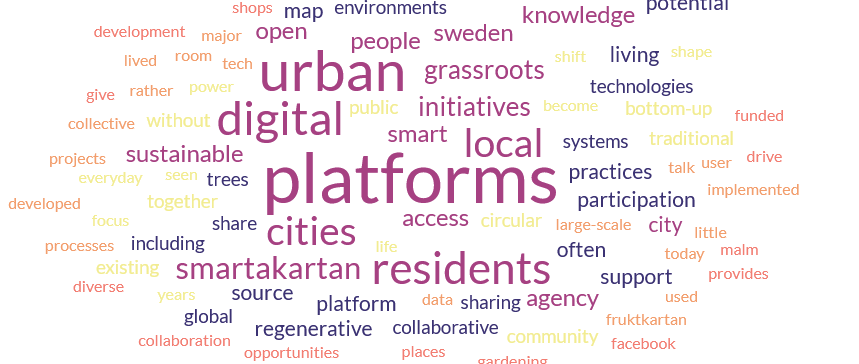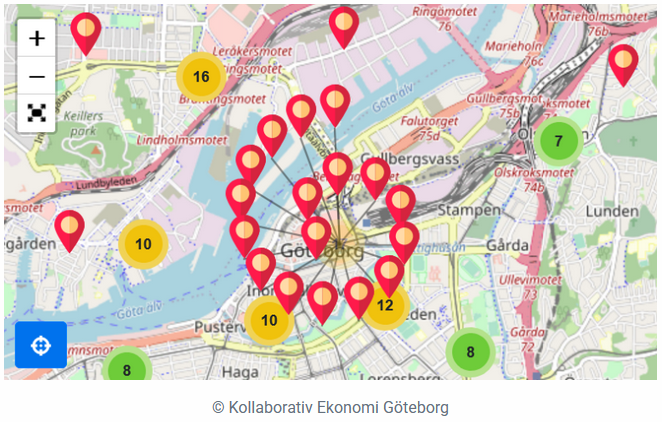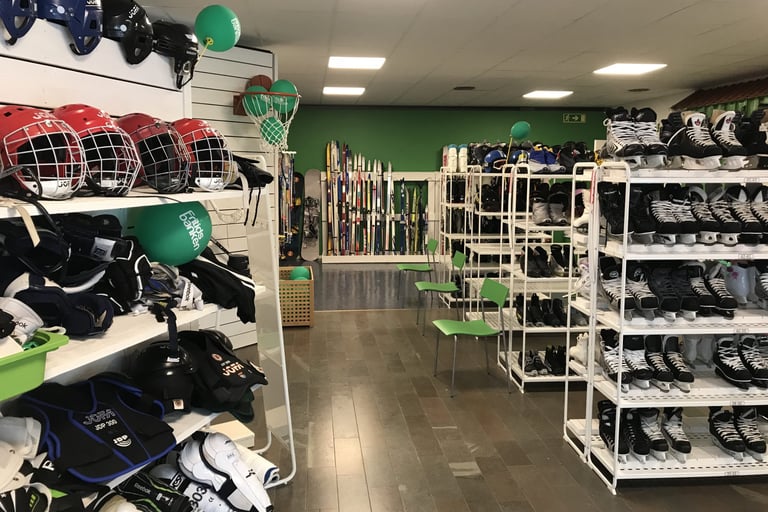Rethinking Smart Cities: The Power of Local Digital Platforms for Urban Sustainability
This blog explores how grassroots digital platforms, like Sweden’s SmartaKartan, are reshaping how we map and share urban resources. It highlights how open-source tools can support local circular economy practices, foster knowledge exchange, and reconnect people with each other, their neighborhoods, and the natural systems around them.
Marie Urfels
5/23/20255 min read


The Digital Shift in Urban Life
Over the past years, we've seen a rise in buzzwords like digitalization, digital platforms, and smart cities. Digital technologies increasingly shape our everyday urban lives, whether it's navigating transportation, paying at the supermarket, or managing daily tasks through our phones and apps.
As these technologies become more integrated into urban environments, the concept of smart cities has gained global traction. While much research has highlighted both the benefits and drawbacks of smart city technologies, such as improvements in digital infrastructure, it has also pointed out the power imbalances these systems can reinforce in urban settings.
A Shift in Focus: Local Platforms for Collective Knowledge
Today, rather than looking at big tech or large-scale urban infrastructure projects, the focus is on local digital platforms that foster knowledge sharing through collaborative, participatory processes. These platforms invite residents to contribute and exchange insights on specific themes, making information more accessible and useful for everyone. In contrast, large-scale initiatives, such as smart traffic control systems, surveillance networks, or centralized data hubs, often led by governments or major tech corporations, aim to optimize city functions on a broad scale but frequently leave little room for grassroots participation or everyday user agency.
Exploring Local Initiatives: SmartaKartan and Beyond
I would like to talk about something called SmartaKartan (englisch The Smart Map), developed here in Sweden and now implemented in various cities in Sweden. I've lived now in Sweden for nine years, and from the beginning, I've seen the use of open source platforms for sustainable living practices used by some residents, including:
FruktKartan – an open source map where trees with edible fruits, including nut trees or berry bushes or apple trees, are mapped in diverse cities of Sweden. Residents can go and pick them in public places, increasing accessibility and reducing food waste.
CoGrow – a relatively new platform connecting residents living in apartments (without access to land) with households that own unused lawns. This supports biodiversity and provides urban residents access to gardening opportunities.
These initiatives are bottom-up, open source platforms that drive sustainable living practices.
In 2018, in collaboration with Gothenburg Stad, the NGO Kollaborativ Ekonomi Sverige scaled up a locally developed open-source map, funded by both the city and the national program Sharing Cities Sweden*. The goal was to promote circular economy practices, encouraging people to rent, exchange, borrow, share, give, and receive, through a platform that highlights services and initiatives such as:
Bike kitchens
Swap groups
Free shops
Car pools
Sharing tool hubs
Plastic-free shops
The platform was very successful and is now implemented in seven Swedish cities including Malmö. It is collaborative, allowing individuals to add information and participate in mapathons, for instance at the public library in Malmö , driving the mapping process together.
What Is the Potential of SmartaKartan?
Seeing the development of these local platforms has got me thinking: What is their potential to really drive change in our cities? Especially as we continue to see bigger platforms like Facebook or Airbnb disrupt urban infrastructure and reinforce existing socioeconomic inequities.
Understanding Platforms: Open vs Closed, Top-Down vs Bottom-Up
Digital platforms are meeting places of people, where interaction, collaboration, and knowledge-sharing happen. Traditionally, platforms existed in physical forms, driven by shared interests and collective goals.
Today, platforms like Airbnb and Facebook create immense user bases and offer conveniences such as global and local connectednes. But they also contribute to:
Economic inequality
Housing market disruptions
Polirization
These large-scale digital platforms differ significantly from traditional ones, as they bring together people with diverse needs, opinions, and agendas, often without the shared values or trust that once underpinned community-based platforms.
E-platforms for digital participation in urban planning have become more common. However, there's a major caveat: when these platforms are used merely to validate or edit exisitng plans, rather than to empower residents with real decision-making power, they end up reinforcing top-down planning structures instead of challenging them.
In addition, many of these platforms are designed and managed in a technocratic, expert-driven way. This can limit genuine participation, as they often prioritize institutional knowledge over local lived experience, leaving little room for community agency or meaningful grassroots engagement.
What Sets SmartaKartan Apart?
SmartaKartan is government funded. However, it does not follow traditional models where residents are simply asked to comment. Instead, it collects grassroots efforts and provides visibility to existing local organizations that support circular living.
This makes it a new form of urban development, highlighting participation, amplifying local agency, and making grassroots efforts more visible and viable in urban environments.
It could even be said that it brings back some of the core values of traditional platforms, where local communities gathered to share common interests and work together to make their environment more inclusive—both for residents and the planet.
Challenges of Digital Participation
Despite its promise, SmartaKartan faces challenges. To participate, residents must be digitally literate and aware of the platform. This excludes elderly residents, individuals without access to digital devices, and others marginalized from digital spaces. Ironically, those who could benefit most from shared, local resources are often the least likely to access them.
To make SmartaKartan more inclusive and impactful, digital participation must be complemented by offline outreach, through libraries, schools, community centers, and neighborhood events, to ensure that all residents are represented in the city’s regenerative transition.
Suggestions for Strengthening SmartaKartan
To broaden its impact and deepen its role in sustainable urban living, SmartaKartan could:
Integrate with other grassroots tools, like FruktKartan, which maps free, publicly available fruit trees
Include urban gardening layers, identifying spaces for community growing and access to food-producing land
Map local green jobs in the circular economy to increase visibility and access to sustainable employment.
Final Thoughts: Who Builds the City?
Cities are shaped not only by planners and policymakers but by the people who live in them and the natural environment around them. Residents shape the life, sustainability, and future of our urban environments. Nature also plays a key role through processes like water cycles, air purification by plants, and support for urban wildlife. This close relationship between people and nature defines the health and character of our cities.
As explored in this article, platforms like SmartaKartan help make visible the local efforts that support circular and sustainable living. They amplify grassroots knowledge, empower local regenerative initiatives, give real agency to urban residents, and challenge the dominance of global tech platforms by centering local needs and values.
To truly build regenerative cities, we must nurture this bottom-up potential, blending technology with inclusion, and digital tools with natural systems, to create urban futures that are smarter, fairer, and more deeply connected
* Sharing Cities Sweden has been funded by the City of Gothenburg and the national program Sharing Cities Sweden. SCS is part of the strategic innovation program Viable Cities, jointly funded by Vinnova, the Swedish Energy Agency (Energimyndigheten) and FORMAS. Business Region Göteborg has also funded sub-projects
Additional Source:
Anttiroiko, Ari-Veikko. (2021). Digital Urban Planning Platforms: The Interplay of Digital and Local Embeddedness in Urban Planning. International Journal of E-Planning Research. 10. 35-49. 10.4018/IJEPR.20210701.oa3. Um






A free lending station in Malmö offers equipment like tennis rackets, basketballs, and ice skates, encouraging active lifestyles and making recreation accessible to all. Photo by Fritidsbanken
SmartaKartan is an open-source platform that connects people and supports sustainable lifestyles by promoting local sharing and the circular economy. Photo by SmartaKartan